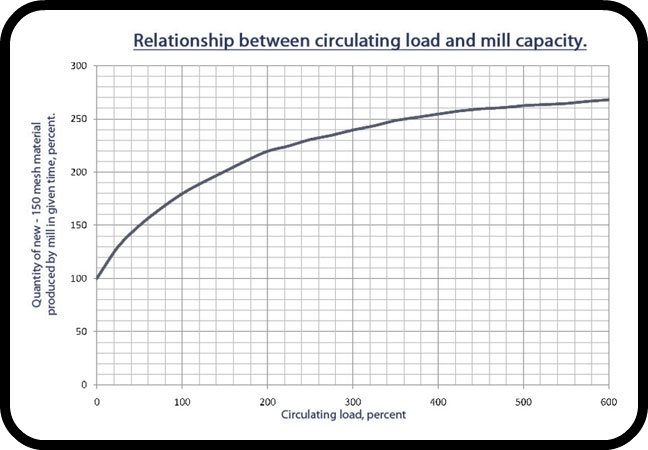Why Do We Need Such a High Recirculating Load in Our Ball Mill?
The ball mill grinds. The cyclones separate. But the pump neither grinds nor separates. So what purpose is served by having such a big pump, which is expensive to operate and maintain in our grinding circuit?
There is a two step answer to this question. The first step is to recognize the relationship between the ball mill circuit circulating load ratio (CLR) and the overall circuit capacity or efficiency. (See Bulletin No. 1 on how to calculate the CLR for your circuit.) See Figure 1. With a CLR of 160% the circuit is close to 2.0 times more productive (efficient) than open circuit (0% CLR). Increasing the circulating load to 500% brings that value up to 2.6 times, for a further relative productivity increase of 30% (2.6/2.0 =1.30). And all this is achieved with the same ball mill power! The most efficient ball milling circuits require a high circulating load ratio. And the pump must be capable of providing it.

The second step is to answer “Why does this relationship exist?” It was Metcom’s Rob McIvor who solved this puzzle. He saw that the size distribution of the material going through the ball mill was much coarser at high CLR vs. low CLR. For example, using the cyclone overflow P80 size of 150 mesh (106 μm) for reference, he observed that the percentage of +150 mesh material inside the ball mill increased from 55% to 71% as the circulating load was increased from 160% to 500%.That meant that the ball mill was expending 71% of its power on the ‘coarse’ (+150 mesh size) material at the high CLR, vs. 55% of its power grinding +150 mesh material at the low CLR. This relative increase in ‘useful’ power delivered to +150 mesh material is 30% (71/55 =1.30). The circuit productivity increased by 30% because 30% more of the mill power was being used to grind the +150 mesh size material! The high circulating load means the slurry passes through the mill quickly, preventing the build-up of fines, and is rapidly sent to the cyclones for removal of the fines from the circuit. The result is a ball mill more filled with coarse (+150 mesh size) solids, and containing fewer fine (-150 mesh size) solids, both absorbing the power of the mill. By maintaining a high percentage of coarse solids in the mill, a high CLR results in a much more efficient grinding circuit.
Metcom coined the term “Classification System Efficiency” (or “CSE”) to describe this phenomenon. It is equal to the percentage of ‘coarse’ material in the ball mill, and thus also equal to the percentage of useful ball mill power. Our on-line training provides a step-by-step-method for plant operators to measure and maximize “CSE”.
Click here to learn more about Classification System Efficiency and to get information on how you can apply it to your plant operation with our new CSE Training Package.
